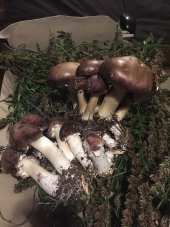posted 1 month ago
Ronaldo,
Just a thought.......
How big/tall is the stump? What species (if you know)? This matters because the type of mushroom that will be best suited will depend on a number of factors.
If the stump is relatively low, maybe a Winecap is the best. Winecaps do best when they have some type of contact with the soil. Also, if the stump is already partially rotted, Winecaps work well with bacteria that inhabit decaying wood. Winecaps are typically found growing on logs that have fallen on the ground so that the fungi can get contact with both the wood and the soil.
If the stump is relatively tall and is fresh/not rotted, then perhaps an oyster is your best option. Oysters do grow really fast--even faster than a Winecap, but they really don't like competition from things coming up from the ground. In a pure wood environment, Oyster mushrooms are in heaven and will grow aggressively. They should break that wood down in no time.
Thoughts?
Eric
Some places need to be wild








